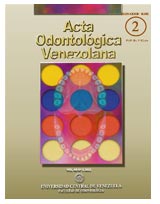EFECTO DE DIFERENTES TÉCNICAS DE PULIDO Y REFRIGERACION EN LA RUGOSIDAD SUPERFICIAL DE UNA RESINA COMPUESTA NANOHIBRIDA
Palabras clave:
resina compuesta, rugosidad, pulido, resin composites, surface roughness, polishingResumen
El objetivo de este trabajo in vitro fue evaluar la rugosidad superficial de una resina compuesta nanohíbrida (Tetric N Ceram®) utilizando 3 técnicas de acabado superficial, con y sin refrigeración. Materiales y método: Fueron confeccionados 60 especimenes (n=10), obtenidos por medio de una matríz metálica (10 x 2 mm). Los especímenes fueron almacenados durante 24 horas en agua destilada a temperatura ambiente, siendo posteriormente divididos en 6 grupos: G1- astropol + refrigeración, G2-astrobrush + refrigeración, G3- astropol + astrobrush + refrigeración, G4-astropol sin refrigeración, G5-astrobrush sin refrigeración, G6- astropol + astrobrush sin refrigeración. La lectura de la rugosidad superficial (Ra) fue realizada 24 horas luego de los respectivos tratamientos por medio de un rugosímetro marca Mitutoyo, tipo SJ - 201P (Japón). Resultados: Los datos fueron sometidos al test de ANOVA (p?0,05) y demostraron que no existe diferencias estadísticamente significantes entre las diferentes técnicas de pulido y refrigeración. Conclusión: La técnica de pulido y refrigeración no interfiere en la rugosidad superficial, por tanto se debe tener en consideración las demás propiedades físicas de las resinas compuestas y el aspecto biológico del diente.
ABSTRACT
The study evaluated in vitro the surface roughness in a nanohibrid composite resin (Tetric N Ceram®) polished with the use three polishing techniques with and without refrigeration. Materials and Methods: Sixty discs (n=10), was made with aid of a metal matrix measuring 10 x 2 mm. The specimens were stored in artificial saliva in an oven at 37oC (±1 oC), for 24 hours. After this time the specimens were submitted to action of astropol + refrigeration (G1), astrobrush + refrigeration (G2), astropol + astrobrush + refrigeration(G3), astropol whithout refrigeration (G4), astrobrush whithout refrigeration (G5), astropol + astrobrush whithout refrigeration (G6). The surface roughness (Ra) of the specimens was avaliated after 24 hours using profilometer (Mitutoyo SJ - 201P - Japon). Results: the data were submitted to Analysis of Variance ANOVA (p?0,05) and were no statistically significant differences detected for each technique. Conclusion: The effect polishing techniques and refrigeration not interferance in the surface roughness, but needed consideration of others properties.


